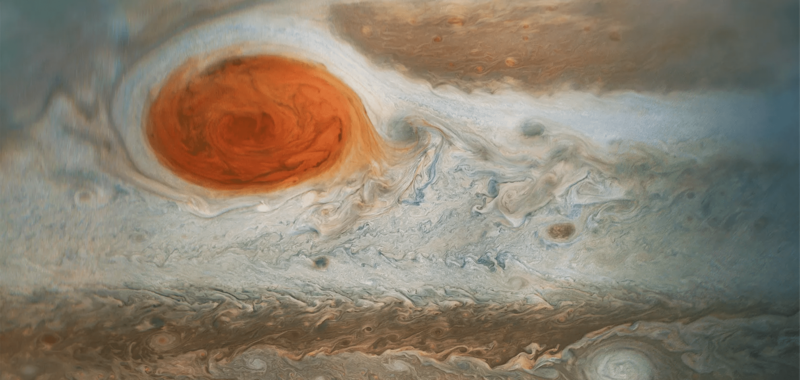If the moon is said to be made of cheese (it’s not), then Jupiter’s famed Great Red Spot (GRS) is more like a bowl of JELL-O. A new look at this enormous anticyclone on our solar system’s largest planet shows it jiggling. These observations were taken with NASA’s Hubble Space Telescope over 90 days between December 2023 to March 2024 and allowed astronomers to assemble time-lapse footage of GRS’ wobbly behavior. The observations are detailed in a study published October 9 in the The Planetary Science Journal.
“While we knew its motion varies slightly in its longitude, we didn’t expect to see the size oscillate. As far as we know, it’s not been identified before,” study co-author and astronomer Amy Simon of NASA’s Goddard Space Flight Center said in a statement. “This is really the first time we’ve had the proper imaging cadence of the GRS. With Hubble’s high resolution we can say that the GRS is definitively squeezing in and out at the same time as it moves faster and slower. That was very unexpected, and at present there are no hydrodynamic explanations.”

The GRS is an anticyclone—a large wind system that rotates counterclockwise around a center of high pressure in a planet’s southern hemisphere and clockwise in its northern. Jupiter’s GRS is big enough to swallow the Earth and keep it engulfed in stormy conditions for at least 150 years. Hubble monitors Jupiter and all of the outer solar system planets through the Outer Planet Atmospheres Legacy program (OPAL). However, these new observations were from a program that is solely dedicated to studying the GRS and all of its surprises. Understanding the mechanics behind the solar system’s larger storms put the theory of hurricanes on Earth into a broader cosmic context. This knowledge could be applied to a better understanding of the meteorology on planets around other stars.
In the study, Simon’s team used Hubble to zoom in on the GRS to take a detailed look at its size, shape, and any subtle changes to its color. A lot of things change day to day on the GRS, including the ultraviolet-light observations that show the distinct core of the storm reaching its brightest point when the GRS is at its largest size in its oscillation cycle. According to the team, this indicates less haze absorption in the upper atmosphere.

“As it accelerates and decelerates, the GRS is pushing against the windy jet streams to the north and south of it,” study co-author and University of California at Berkeley planetary scientist Mike Wong said in a statement. “It’s similar to a sandwich where the slices of bread are forced to bulge out when there’s too much filling in the middle.”
By contrast, the planet Neptune has dark spots that can drift widely in latitude without strong jet streams holding them in place. Jupiter’s GRS has been at a southern latitude, trapped between the jet streams, for as long as Earth-bound telescopes have been observing it.
[Related: Jupiter’s Great Red Spot keeps shrinking.]
The team has been watching the GRS continue to shrink since the OPAL program began 10 years ago. They predict that it will keep getting smaller before eventually taking on a stable and less-elongated shape.
“Right now it’s over-filling its latitude band relative to the wind field. Once it shrinks inside that band the winds will really be holding it in place,” said Simon. The team predicts that the GRS will probably stabilize in size, but for now Hubble only observed it for one oscillation cycle.

